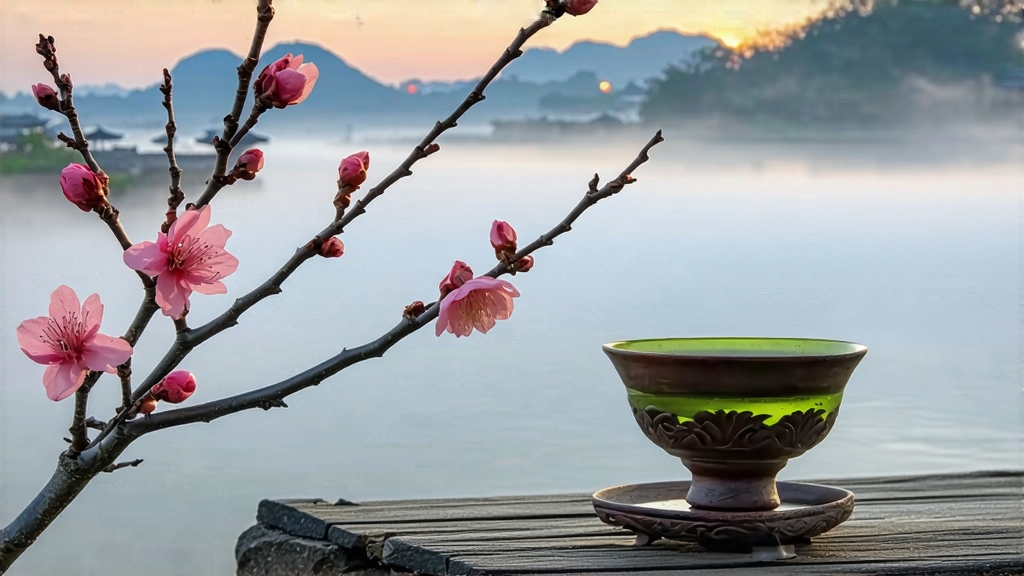
Among the countless shades of green that paint China’s tea hills, few leaves are as diminutive yet as aromatically explosive as Biluochun. Transliterated as “Green Snail Spring,” the name itself is a miniature poem: bi for jade-green, luo for the tight spiral that resembles a snail shell, and chun because the tea is plucked at the very outset of spring when the mountain air still carries winter’s chill. International drinkers who meet it for the first time often confess that they have never encountered a green tea so small in leaf yet so immense in fragrance; the tiny curls, no larger than a bee’s thorax, release an orchid-peach perfume that seems almost impossible for something that has never been scented with flowers. To understand Biluochun is to step into the overlapping histories of imperial taste, Buddhist monks, lake-born mists, and the patient hands of farmers who still count the number of wok tosses per minute in order to keep their family’s reputation alive.
Historical roots
The earliest written record appears in the Tea Canon of the Tang dynasty (618-907 CE), where the lake region now called Taihu is praised for “curls of jade that float like duckweed yet taste of nectar.” The modern name, however, crystallized during the Kangxi reign (1662-1722) of the Qing. Legend claims the emperor was traveling incognito through Suzhou when local officials served him an unnamed tea whose “astonishing fragrance preceded the liquor.” Delighted, he asked its name but disliked the vulgar original—“Xia Sha Ren Xiang,” literally “scary fragrance.” On the spot he rechristened it Biluochun for its color, shape, and season. Whether apocryphal or not, the story secured the tea’s entry into the imperial tribute list, elevating it alongside Longjing, Huangshan Maofeng, and Lu’an Guapian. For three centuries the tiny spirals were carried by canal boat and horseback to Beijing, wrapped in silk and lotus leaves to preserve their volatile aromatics.
Micro-terroir: Dongting’s misty islands
Authentic Biluochun comes only from the east and west Dongting mountains that rise from Taihu Lake in Jiangsu Province. The lake’s vast surface acts as a thermal regulator, creating a microclimate where early-spring mornings are blanketed in cool mist. The humidity slows photosynthesis, forcing the tea bush to synthesize more amino acids—especially L-theanine—yielding the famed “umami-sweet” core that balances the tea’s floral top notes. Peach, plum, and loquat trees are interplanted among the tea bushes; their blossoms fall like snow, their roots exchange soil microbes, and their scent is said to be absorbed by the tender leaf. Soil scientists describe a light acidic loam rich in quartz and shell deposits, a geology that encourages fine rootlets and concentrates trace minerals responsible for the subtle “stone fruit” aftertaste.
Cultivar lineage
The predominant clone is a small-leaf variety of Camellia sinensis var. sinensis locally called “Dongting Qunti.” Unlike modern clonal hybrids bred for yield, Qunti is a seed-propagated population with measurable genetic diversity; each bush ripens at a slightly different hour, giving farmers a staggered picking window of only ten days. In the past two decades the Tea Research Institute of Jiangsu has released improved selections—Jiangsu 1, 2, and 7—yet connoisseurs still prize the old Qunti for its lower catechin-to-theanine ratio, which translates into softer astringency and a creamier mouthfeel.
Plucking discipline
The orthodox standard is “one bud with the just-opened first leaf,” no longer than 2.5 cm and weighing no more than 0.3 g fresh. Experienced pickers use a twisting motion rather than a snap to keep the tiny stem base intact; any rupture will oxidize and turn red under the wok’s heat. Picking begins at dawn when the leaf’s surface temperature is below 12 °C; by 9 a.m. the rising sun raises essential-oil volatilization and the leaf must already be in the village courtyard, spread on bamboo trays for the first withering.
Crafting the spiral: six hours from garden to shelf
Biluochun is the only famous Chinese green tea whose shaping and killing